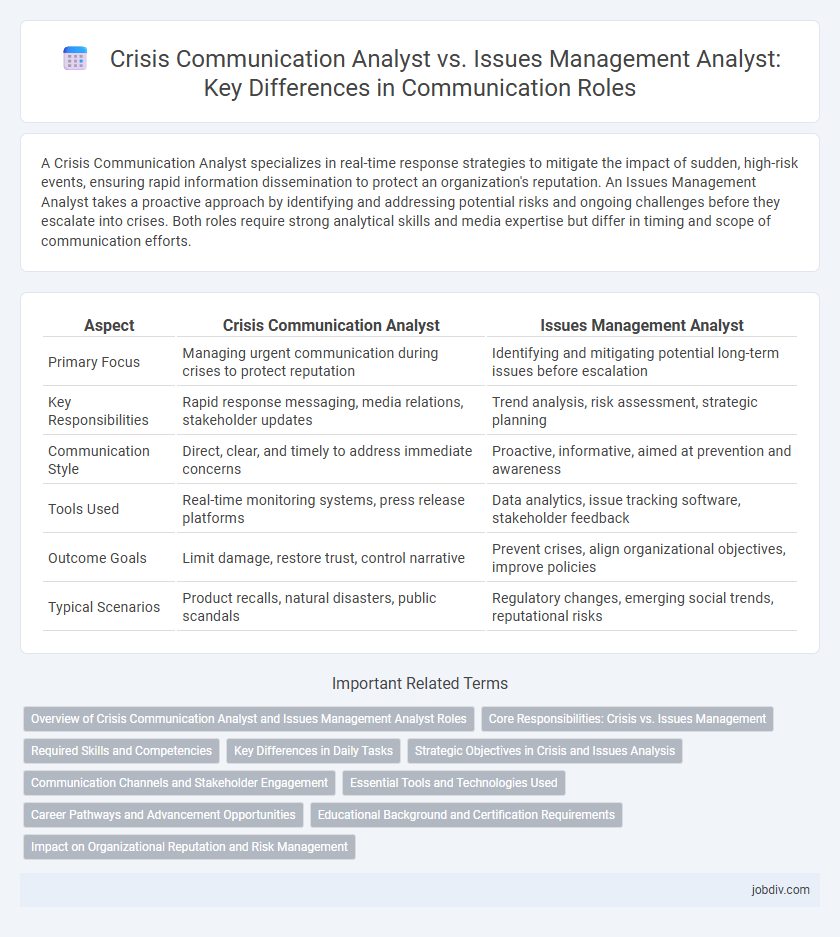A Crisis Communication Analyst specializes in real-time response strategies to mitigate the impact of sudden, high-risk events, ensuring rapid information dissemination to protect an organization's reputation. An Issues Management Analyst takes a proactive approach by identifying and addressing potential risks and ongoing challenges before they escalate into crises. Both roles require strong analytical skills and media expertise but differ in timing and scope of communication efforts.
Table of Comparison
| Aspect | Crisis Communication Analyst | Issues Management Analyst |
|---|---|---|
| Primary Focus | Managing urgent communication during crises to protect reputation | Identifying and mitigating potential long-term issues before escalation |
| Key Responsibilities | Rapid response messaging, media relations, stakeholder updates | Trend analysis, risk assessment, strategic planning |
| Communication Style | Direct, clear, and timely to address immediate concerns | Proactive, informative, aimed at prevention and awareness |
| Tools Used | Real-time monitoring systems, press release platforms | Data analytics, issue tracking software, stakeholder feedback |
| Outcome Goals | Limit damage, restore trust, control narrative | Prevent crises, align organizational objectives, improve policies |
| Typical Scenarios | Product recalls, natural disasters, public scandals | Regulatory changes, emerging social trends, reputational risks |
Overview of Crisis Communication Analyst and Issues Management Analyst Roles
Crisis Communication Analysts specialize in managing and mitigating the impact of unexpected events that threaten an organization's reputation, focusing on rapid response, message control, and stakeholder engagement during emergencies. Issues Management Analysts proactively identify potential risks and emerging trends, developing strategic plans to address ongoing challenges before they escalate into full crises. Both roles require strong analytical skills and strategic communication expertise, but Crisis Communication Analysts prioritize immediate containment, while Issues Management Analysts emphasize prevention and long-term risk mitigation.
Core Responsibilities: Crisis vs. Issues Management
A Crisis Communication Analyst focuses on immediate response strategies during high-impact events to protect an organization's reputation and manage stakeholder perceptions in real-time. An Issues Management Analyst monitors emerging trends and potential risks, developing proactive strategies to mitigate long-term threats and align with organizational objectives. Both roles require expertise in risk assessment and messaging but differ in timing and scope of intervention.
Required Skills and Competencies
Crisis Communication Analysts must possess exceptional skills in risk assessment, rapid decision-making, and media relations to effectively manage urgent situations and safeguard organizational reputation. Issues Management Analysts require strong competencies in trend analysis, stakeholder engagement, and strategic planning to proactively identify and address potential challenges before they escalate. Both roles demand excellent communication skills, adaptability, and a deep understanding of organizational dynamics and external environments.
Key Differences in Daily Tasks
Crisis Communication Analysts primarily monitor real-time events, rapidly crafting responses to mitigate immediate damage and maintain organizational reputation during emergencies. Issues Management Analysts focus on identifying, assessing, and addressing emerging risks through strategic planning and stakeholder engagement to prevent potential crises. The key difference lies in the Crisis Communication Analyst's reactive role versus the proactive, preventive approach central to Issues Management Analysts.
Strategic Objectives in Crisis and Issues Analysis
A Crisis Communication Analyst prioritizes rapid response strategies to mitigate reputational damage during unexpected high-impact events, focusing on real-time risk assessment and stakeholder engagement. An Issues Management Analyst emphasizes proactive identification and long-term monitoring of emerging concerns to align organizational objectives with evolving social, political, and regulatory landscapes. Both roles integrate data-driven insights and strategic objectives to ensure effective communication planning, but crisis analysts excel in immediate containment while issues analysts focus on preventative, sustained management.
Communication Channels and Stakeholder Engagement
Crisis Communication Analysts specialize in real-time communication channels such as social media, emergency alerts, and press releases to swiftly manage stakeholder engagement during high-pressure events. Issues Management Analysts focus on monitoring long-term communication channels like surveys, newsletters, and stakeholder meetings to proactively address emerging risks and maintain ongoing dialogue. Both roles employ targeted strategies to optimize messaging and ensure transparent, consistent communication across diverse stakeholder groups.
Essential Tools and Technologies Used
Crisis Communication Analysts rely heavily on real-time monitoring software, sentiment analysis tools, and social media platforms to quickly identify and respond to emerging threats, ensuring timely and accurate messaging. Issues Management Analysts utilize risk assessment models, stakeholder mapping technologies, and scenario planning software to proactively identify potential problems and develop long-term strategic solutions. Both roles employ advanced analytics and communication management systems, but Crisis Communication Analysts emphasize rapid response tools, while Issues Management Analysts prioritize predictive and planning technologies.
Career Pathways and Advancement Opportunities
Crisis Communication Analysts specialize in managing urgent, high-stakes situations requiring immediate response and strategic messaging, often progressing to roles like Crisis Manager or Director of Corporate Communications. Issues Management Analysts focus on identifying and addressing emerging risks and trends to prevent potential crises, typically advancing to senior roles in risk management or public affairs. Career pathways for both roles demand strong analytical skills, media savvy, and the ability to influence organizational strategy while offering opportunities to lead integrated communication teams in dynamic environments.
Educational Background and Certification Requirements
Crisis Communication Analysts typically hold degrees in communications, public relations, or journalism, often supplemented by certifications like the Certificate in Crisis Communication from the Public Relations Society of America (PRSA). Issues Management Analysts generally pursue education in public relations, political science, or business administration, with certifications such as the Accredited in Public Relations (APR) designation enhancing their credentials. Both roles benefit from specialized training in risk assessment and strategic communication to effectively manage organizational reputation during challenges.
Impact on Organizational Reputation and Risk Management
Crisis Communication Analysts specialize in rapid response strategies that mitigate immediate threats to organizational reputation during unforeseen events, minimizing reputational damage and financial loss. Issues Management Analysts proactively identify and address emerging risks or public concerns to prevent escalation, ensuring long-term reputational stability and regulatory compliance. Both roles critically enhance risk management by aligning communication tactics with organizational objectives, safeguarding brand integrity and stakeholder trust.
Crisis Communication Analyst vs Issues Management Analyst Infographic

 jobdiv.com
jobdiv.com